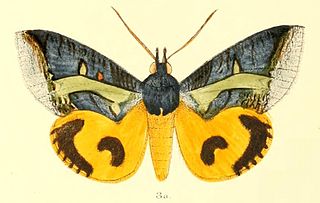
Gangara lebadea, commonly known as the banded redeye, is a species of hesperid butterfly found in Southeast Asia.

Corcobara is a monotypic moth genus of the family Erebidae first described by Frederic Moore in 1882. Its only species, Corcobara angulipennis, described by the same author in the same year, is found in India, Thailand, Cambodia, Myanmar, Malaysia, Indonesia, New Guinea, Sri Lanka and the Solomons.

Eudocima homaena is a moth of the family Erebidae first described by Jacob Hübner in 1816. It is found in the Indian subregion, Sri Lanka, Myanmar, Taiwan, the Nicobars, Peninsular Malaysia, Borneo, the Philippines and on Christmas Island. It is a major pest on orange plants.

Cosmopterix galapagosensis is a moth of the family Cosmopterigidae. It is known from the Galapagos Islands.
Alatuncusia gilvicostalis is a moth in the family Crambidae. It was described by George Hampson in 1918. It is found in Peru.
Clupeosoma atristriata is a moth in the family Crambidae. It was described by George Hampson in 1917. It is found in Papua New Guinea, including the Bismarck Archipelago and Indonesia, where it has been recorded from Timur.
Apilocrocis albicupralis is a moth in the family Crambidae. It was described by George Hampson in 1918. It is found in Peru.
Apilocrocis albipunctalis is a moth in the family Crambidae. It was described by George Hampson in 1918. It is found in Ecuador and Bolivia.
Phostria euryleucalis is a moth in the family Crambidae. It was described by George Hampson in 1918. It is found in Peru.
Phostria internervalis is a moth in the family Crambidae. It was described by George Hampson in 1918. It is found in Colombia.
Phostria purpureonitens is a moth in the family Crambidae. It was described by George Hampson in 1918. It is found on Woodlark Island in Papua New Guinea.
Pilocrocis metachrysias is a moth in the family Crambidae. It was described by George Hampson in 1918. It is found in Peru.
Sinomphisa junctilinealis is a moth in the family Crambidae. It is found in Sierra Leone and Uganda.
Syllepte subcyaneoalba is a moth in the family Crambidae. It was described by George Hampson in 1918. It is found in Cameroon.
Syllepte brunneiterminalis is a moth in the family Crambidae. It was described by George Hampson in 1918. It is found in Kenya and Nigeria.
Udea poliostolalis is a moth in the family Crambidae. It was described by George Hampson in 1918. It is found in Taiwan.
Ambia fulvicolor is a moth in the family Crambidae. It was described by George Hampson in 1917 and it is found in New Guinea.

Semioptila flavidiscata is a moth in the Himantopteridae family. It was described by George Hampson in 1910. It is found in South Africa, Zambia and Zimbabwe.

Austramathes purpurea is a species of moth in the family Noctuidae. It is endemic to New Zealand and can be found throughout the North and South Islands but has yet to be recorded at Stewart Island. It inhabits native forest. This species might possibly be confused with A. pessota, however this latter species does not have the purple hue to the forewings. The larvae of A. purpurea feed primarily on māhoe but have been recorded as feeding on, and have been reared on, narrow-leaved māhoe. The larvae pupate in a silken cocoon on moss covered ground. Adults can be found on the wing during the months of March to January but mainly occur during New Zealand's late autumn, winter, and spring. Light trapping may not be the most efficient technique for collecting this species.

Ichneutica chlorodonta, also known as the Green-toothed Owlet, is a moth of the family Noctuidae. This species is endemic to New Zealand. It is found throughout the North, South and Stewart Islands and is associated with native forest and shrubland. It can be confused with similar looking species such as I. subcyprea however I. chlorodonta can be distinguished through differences in colouration of its fore and hind wings as well as the length of the male pectinations. The life history of this species is unknown as are the host species of its larvae but adults of I. chlorodonta are on the wing from September to April.





